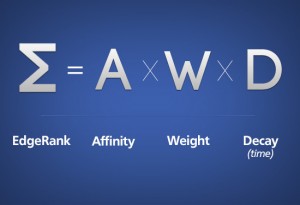Ever since Facebook launched in 2004, the social network has used an ever-evolving algorithm to place certain images, advertisements, and status updates (which can also be advertisements) in users’ News Feeds. As advertising has become an integral component of Facebook (and its revenue model), the algorithm has evolved to favor content and advertising that performs better. At one point, Facebook used an algorithm called EdgeRank to measure the relevance of advertising and page post content that would impact which users would see these posts, and how often. In 2013, Facebook updated their algorithmic formula again, slowly introducing new concepts that would ultimately favor more relevant, tailored ads and “quality” content.
Of course, while these changes impact Facebook users, they also impact marketers who rely on Facebook as an advertising platform. If you’re a marketer that’s been left more than a little confused by Facebook’s algorithm changes over the past few years, don’t worry – we’ve got you covered. Here’s an overview of these changes and how they affect you.
History of Facebook’s Algorithm Update
Facebook introduced the News Feed in 2006 to help users find “what’s happening in your social circles on Facebook. It updates a personalized list of news stories throughout the day, so you’ll know when Mark adds Britney Spears to his Favorites or when your crush is single again.” (Facebook’s vision of their News Feed was clearly much more simple – and a little more silly – than it is today.) At the time, “News Feed ranking was turning knobs,” said Facebook VP of Product Chris Cox during a recent News Feed media event. “Turn up photos a little bit, turn down platform stories a little bit.”
 But then, in 2007, things got a little complicated when Facebook introduced EdgeRank, a way to qualify which pieces of content showed up in each users’ News Feeds. EdgeRank consisted of three aspects; Affinity, Weight and Decay. Affinity asked how close the relationship was between the user and the content/source, while Weight asked what type of action was taken on the content. Decay essentially asked how recent/current was the content, which helped show more recent content higher in News Feeds.
But then, in 2007, things got a little complicated when Facebook introduced EdgeRank, a way to qualify which pieces of content showed up in each users’ News Feeds. EdgeRank consisted of three aspects; Affinity, Weight and Decay. Affinity asked how close the relationship was between the user and the content/source, while Weight asked what type of action was taken on the content. Decay essentially asked how recent/current was the content, which helped show more recent content higher in News Feeds.
As Facebook continued to acquire more users (passing the 1 billion mark) and advertising became a core component of Facebook’s business plan, EdgeRank in turn became more complicated. In fact, at any given moment, the typical Facebook user has about 1,500 stories that could show in their News Feed on every visit. To help users sort through this potential noise, there are now multiple weighted levels for each component of Facebook’s algorithm, which is no longer even referred to internally as EdgeRank. In fact, each component of what was EdgeRank – Affinity, Weight and Decay – now have categories and subcategories of their own. To make matters even more complicated for marketers, there are now relationship settings that impact what users see, different post types that impact visibility, and the ability for users to hide what types of post they see to completely customize their own algorithm – each of which advertisers have very little control over and insight into.
The Shift to Surfacing Quality Content
Towards the end of 2013, Facebook made one of its most substantial shifts in its algorithm changes by reversing one aspect of its algorithm that marketers have come to love over the years. Previously, photos had a very heavy weight in Facebook’s algorithm, and brands were very keen to leverage this to get in front of users. Now, Facebook will be demoting the value of what they call “meme photos” and other links that aren’t as informative. Inline with this change is a shift to promoting what Facebook says is “high-quality” articles that readers are likely to click on.
The shift to an emphasis on quality content from brands on Facebook means that marketers will need to rely more on articles and positioning of this content with better CTA’s that entice users to click on the link, like or comment on the post – and rely less on photos of cute fluffy kittens to drive engagement on the social network. If marketers aren’t currently focused on content marketing, Facebook’s latest algorithm change should inspire these marketers to consider otherwise, as there are now fewer ways to organically reach audiences on Facebook.
The Impact of Advertising
 Every time someone visits the News Feed, Facebook’s algorithm chooses between thousands of ads to determine the best ads – also called impressions – to show. Facebook strives to show people the most relevant ads based on their interests and the Pages they like, and to choose the right ads, the company listens to both users and marketers using it’s RTB network.
Every time someone visits the News Feed, Facebook’s algorithm chooses between thousands of ads to determine the best ads – also called impressions – to show. Facebook strives to show people the most relevant ads based on their interests and the Pages they like, and to choose the right ads, the company listens to both users and marketers using it’s RTB network.
When it comes to the influence marketers have on the advertisements Facebook displays, marketers can take advantage of Facebook’s intent on showing the most relevant ad by carefully targeting their ad campaigns. Marketers can also specify how much they are willing to pay to show an ad, which directly correlates to just how important reaching that specific audience is to them.
Facebook users also influence what types of ads they see (and conversely don’t see) by engaging with ads via clicks, likes, comments, and shares. When someone hides an ad, News Feed learns that that person wants to see less of those types of ads.
Now, Facebook will be improving the relevance and quality of the ads people see by placing more emphasis on feedback they receive from people about ads, including how often people report or hide an ad. Ultimately, this means that people should see ads that are increasingly relevant to them, and fewer ads that they generally are not interested in.
For marketers, this means Facebook will show ads to users who will likely want to see them the most. Ultimately this will be better for marketers as their content will reach people who will actually be interested in what you have to offer, which will lead to higher engagement and conversion rates.
What Marketers Need To Know about Facebook’s Algorithm for 2014
As Facebook’s algorithm continues to evolve, there will undoubtedly be more changes that marketers should be aware of. As we approach and head into 2014, marketers should not only be aware of the increasing importance of quality content and the ability for users to personalize their advertising experience, but also the placement of content on the News Feed. Facebook has started to bump stories with new comments, and with this update, content will resurface higher in the News Feed that have new comments from friends. In 2014, marketers will want to encourage conversations on Facebook more than ever as a boosted story targeted to friends-of-fans can continually resurface if those friends join the conversation on Facebook, which can help convert those friends-of-fans to actual fans (and then customers).
 Marketers will also want to pay close attention to what Facebook’s algorithm changes mean for mobile in 2014. Facebook points out that as part of their shift to promoting high quality content, users will see links to articles more often – particularly on mobile. As Facebook’s mobile user base jumped 45% year-over-year, marketers will not only want to focus on creating quality content, but optimizing that content for mobile devices.
Marketers will also want to pay close attention to what Facebook’s algorithm changes mean for mobile in 2014. Facebook points out that as part of their shift to promoting high quality content, users will see links to articles more often – particularly on mobile. As Facebook’s mobile user base jumped 45% year-over-year, marketers will not only want to focus on creating quality content, but optimizing that content for mobile devices.
Finally, while marketers will want to focus on pushing link posts, you will also want to stay savvy about Facebook’s evolving algorithm. The social network is constantly making changes and at any moment could again reverse the types of posts that behoove its best interests. As consumers demand more privacy and control of the type of data they share, it wouldn’t be a surprise if Facebook offers users more options to control the type of content they see in 2014 – especially content from advertisers. As such, marketers should be always be prepared to reach audiences on Facebook in new ways should the algorithm change yet again.
Author
Becky is the Senior Content Marketing Manager at TUNE. Before TUNE, she led a variety of marketing and communications projects at San Francisco startups. Becky received her bachelor's degree in English from Wake Forest University. After living nearly a decade in San Francisco and Seattle, she has returned to her home of Charleston, SC, where you can find her enjoying the sun and salt water with her family.




Leave a Reply
You must be logged in to post a comment.